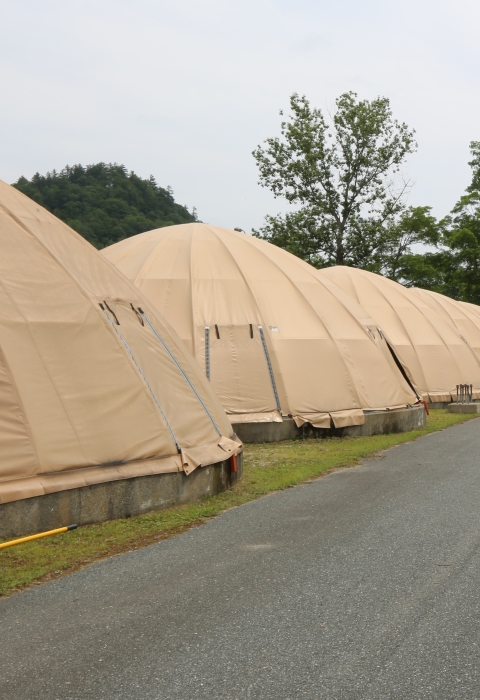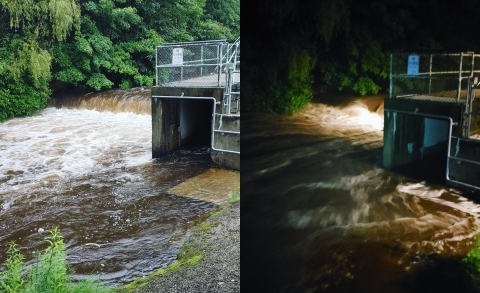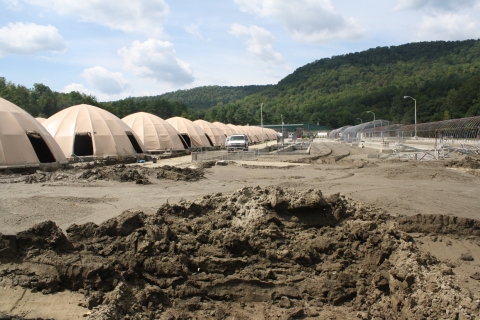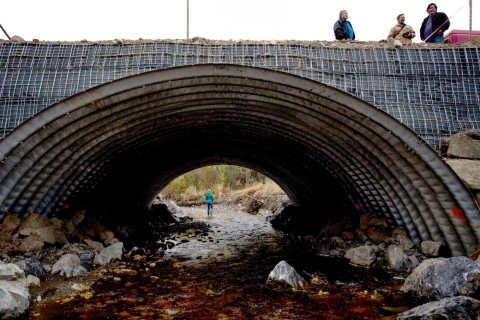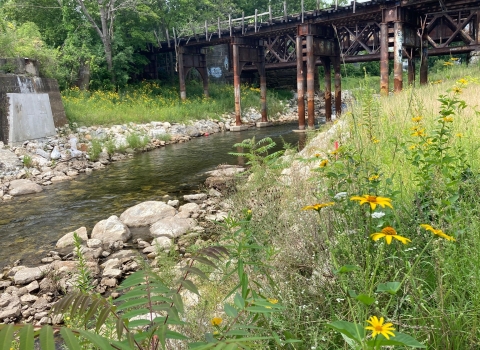Just after midnight on Saturday, July 15, 2023, Shane Hanlon awoke to an emergency alarm call from the Dwight D. Eisenhower National Fish Hatchery. He rushed to the site in North Chittenden, Vermont, and immediately noticed that Furnace Brook, the creek that supplies water to the hatchery, was exceptionally high.
“We have a photograph [of] the highest they’ve ever seen it. This was maybe six inches lower than that level,” said Hanlon.
The alarm wasn’t triggered by the rising water, but by another shocking situation: The hatchery’s sediment basin, which receives water from the river intake and is typically filled and flowing with fresh brook water on its way to supply the hatchery fish, was completely empty.
Fortunately, the loss of water in this part of the system doesn’t mean immediate death for the fish. They can survive in the hatchery raceways in stagnant water for up to an hour before their oxygen supply becomes dangerously low. But the clock was ticking.
The high water level in the brook had created a siphoning effect that pulled the water out of the hatchery system, back into Furnace Brook. With a valve adjustment to change the flow dynamics, Hanlon had water flowing to the fish once more.
“People let their guards down on Tuesday, but the impact we had here was on Saturday,” he said, referring to the devastating flooding that had happened throughout the state of Vermont five days before.
Furnace Brook hadn’t overflowed earlier in the week, while other areas of Vermont swirled underwater. But because the ground was already saturated, isolated thunderstorms on Friday produced runoff that contributed to the sudden water-level rise just in time for the weekend. It was a reminder that climate change climate change
Climate change includes both global warming driven by human-induced emissions of greenhouse gases and the resulting large-scale shifts in weather patterns. Though there have been previous periods of climatic change, since the mid-20th century humans have had an unprecedented impact on Earth's climate system and caused change on a global scale.
Learn more about climate change can be a challenge in unexpected ways and at unexpected times.
Flooded before
Hanlon, manager at the hatchery, wasn’t initially concerned for Dwight D. Eisenhower Hatchery when he saw the flood warnings across Vermont. The hatchery had survived Hurricane Irene in 2011 with minimal impact. But he did have his eye on the other site he manages, White River National Fish Hatchery in Bethel.
The flooding caused by Irene was devastating at White River Hatchery, engulfing circular rearing pools and raceways and depositing a thick layer of sediment throughout the facility. Some fish escaped, but, disoriented by the high-velocity and muddy water, many ended up in flooded fields and forests. When the water receded, they perished. The fish that remained in the hatchery were potentially contaminated with didymo, or rock snot, an invasive alga from the river. With the hatchery in disrepair, staff released or donated the remaining fish and closed the doors.
The temporary closure coincided with the decision to end our conservation program to restore migratory Atlantic salmon to the Connecticut River. Prior to Irene, the hatchery produced about five million young salmon each year to release in the river’s tributaries.
As we rebuilt the hatchery, we refreshed our strategy. Five years later, the hatchery reopened with a new mission that includes raising and maintaining broodstocks of landlocked Atlantic salmon and lake trout to support restoration of populations in Lake Champlain, as well as Lake Erie and Lake Ontario. The fish at the hatchery are now larger, older and cared for over multiple years, making them high value.
“If we lose those fish, we lose production,” said Hanlon.
Fortunately, during the July 2023 flooding, the White River didn’t rise nearly as high as it had during Irene, cresting about five feet below the level at which it would have affected the hatchery. Hanlon’s team was prepared for the worst though, moving vehicles to higher ground and leaving early to avoid being stranded if access roads flooded. With rising, turbulent waters across the state that surpassed Irene levels in areas, some employees had more pressing needs to take care of at home. In the end, everyone remained safe, the hatchery survived, and so did the fish.
Committed to flood resilience
After Hurricane Irene, Vermonters rebuilt intentionally, preparing to face future storms. Over the last 200 years, humans have reshaped the waterways, as towns and industry popped up alongside, forcing rivers and streams straighter and deeper than they would naturally be and often disconnecting them from their natural floodplains.
As a result, they’re also faster and more dangerous in flood scenarios. Rather than slowly flowing around structures, raging floodwaters can lift buildings off their foundations. The key to increasing resilience, though somewhat counterintuitive, is to remove barriers, allowing waterways to return to their genuine courses and expand into their natural floodplains when necessary, reducing the power of floodwaters.
With this in mind, we’ve joined federal, state, municipal and private partners to deconstruct five old dams along branches of the White River; plant and maintain buffer zones on riverbanks; and replace ineffective culverts with newer, higher-volume versions in the years since Hurricane Irene.
Now, with the dams removed, communities upstream have a lower flood risk and, at the same time, fish can travel freely throughout the river, some migrating to where they reproduce. And while the higher-volume culverts carry more water, the new designs are also bottomless, which prevents erosion from creating sudden drop-offs and ensures fish and other animals can pass through easily. At its core, aquatic connectivity supports flood resilience and vice versa.
This work to improve fish passage fish passage
Fish passage is the ability of fish or other aquatic species to move freely throughout their life to find food, reproduce, and complete their natural migration cycles. Millions of barriers to fish passage across the country are fragmenting habitat and leading to species declines. The U.S. Fish and Wildlife Service's National Fish Passage Program is working to reconnect watersheds to benefit both wildlife and people.
Learn more about fish passage complements the fish hatcheries’ restoration efforts, allowing fish like landlocked Atlantic salmon to swim upstream to their spawning grounds and complete their life cycles.
While benefiting from these projects in the watershed, hatchery staff recognize that other floods are still to come and aren’t necessarily singular, predictable events. Case in point: The rising waters at Dwight D. Eisenhower Hatchery that arrived nearly a week after the heavy-rain event.
White River Hatchery was built close to the river to use the water for fish production, but it now uses well water. One “worst-case” option for reducing flood risk is to move it to another site out of the floodplain.
Meanwhile, flood prevention efforts at the current location could include building a levee, but as Hanlon reminded, “That could actually cause a bigger problem, because the whole idea of a floodplain is to dissipate the energy of the river… so the problem could be worse, especially for people downstream.”
For now, when it comes to flooding, they’ll go with the flow.
The climate change grind
Beyond the threat of another major flood, the teams at our Vermont national fish hatcheries are faced with daily challenges and head-scratchers brought on by a warming climate.
At White River Hatchery, two wells supply water to the adult landlocked Atlantic salmon and lake trout in the hatchery. These coldwater fish require specific temperatures to spawn successfully, so the hatchery team mixes the two well water supplies to create the ideal temperature that they would experience in the wild.
But the hatchery team has noticed that it’s getting harder and harder to keep the water cool, as both wells’ temperatures rise beyond what they’ve been in the past.
“We’re starting to see record high temperatures in our wells, and it’s making it difficult for us to create the temperature we need to set the fish up for spawning,” Hanlon explained.
Meanwhile, erratic winters are making staff at Dwight D. Eisenhower Hatchery frazzled, or rather creating frazil ice in Furnace Brook. In this slushy state, the temperature differential between the air and water forms tiny ice crystals, and they stick to everything, including the opening of the hatchery’s water intake.
To keep water flowing, workers scrape away the slush from the intake whenever it builds up, often at night. Once the brook completely freezes over, the ice cover insulates the water and prevents frazil from forming — problem solved! Except Vermont’s winters haven’t been what they used to be and tend to follow repeating cycles of deep freeze, then rain and thaw. For hatchery staff, the frazil fight continues all winter long.
An upstream battle
After the July 2023 flooding, Vermont farmers, business owners and homeowners found themselves picking up, assessing the damage and rebuilding their lives, even as pounding storms and flooding continued into August in some areas. Recovering from flood destruction, worrying about the next big natural disaster and dealing with the daily impacts of climate change can be exhausting.
Staff at our national fish hatcheries, grateful to be spared this time, are marching on. Workers respond to emergency alerts — often caused by storm-related power outages — at all hours. At White River Hatchery, they monitor the well-water temperatures and when necessary, employ alternatives, like a water chiller system. But this is costly, uses more electricity and counters our goals for carbon reduction. In winter, they scrape away the frazil from the water intake at Dwight D. Eisenhower Hatchery, even when it freezes in the middle of the night.
They also experiment with new solutions: This winter, they will test running well water over the water intake to keep the temperature more stable and prevent the frazil ice from forming.
It’s normal to feel tired, small and hopeless in the wake of destructive events. Fortunately, as humans, we’re resilient, and as an agency, we’re taking cues from nature to respond. Even when there isn’t a clear path forward, we can follow the example of migrating Atlantic salmon: Face the current and just keep swimming.
